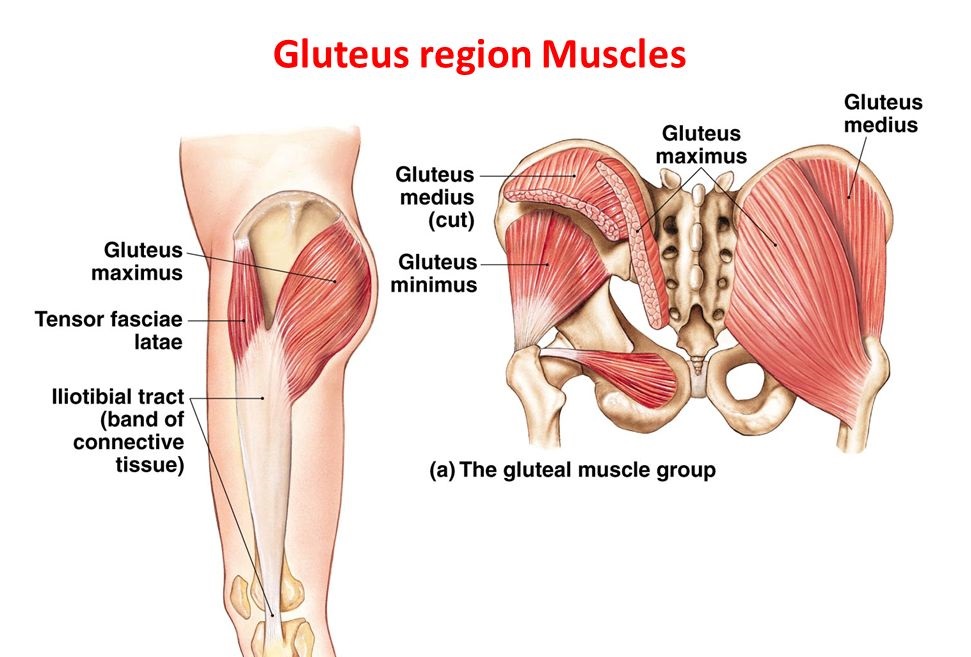What is the gluteus maximus muscle?
The gluteus maximus is the largest and most superficial muscle in the human body. It is located in the buttocks and is responsible for extending and rotating the hip joint. Alongside the gluteus medius and gluteus minimus it helps to stabilize the pelvis and keep the trunk upright.
Origin, insertion and function
Origin:
The gluteus maximus originates from the posterior gluteal line of the ilium, the posterior portion of the sacrum, the coccyx and the sacrotuberous ligament. (1)
Insertion:
The gluteus maximus inserts on the iliotibial tract of the fascia lata, the gluteal tuberosity of the femur, and the iliotibial band.
Function:
The gluteus maximus is the primary extensor of the hip joint, meaning it straightens the hip. It also works to rotate the hip outward and assists in laterally rotating the thigh when the thigh is fixed. Additionally, it helps in maintaining the upright position of the trunk, and also plays a role in stabilizing the pelvis.

Common signs of weak gluteus maximus muscles
Signs that your gluteus maximus could be weak include:
- Difficulty standing up from a seated position or climbing stairs
- Lower back pain or discomfort
- Knee pain, particularly when running or walking
- Difficulty maintaining proper posture, such as a tendency to lean forward
- Limited range of motion in the hips or difficulty performing exercises that involve hip extension
- Weakness or fatigue in the buttocks and thighs
- An imbalance in muscle development, with stronger quadriceps and weaker glutes.
Exercises that strengthen the gluteus maximus
These exercises help make the gluteus maximus stronger:
Squats
- Stand with feet hip-width apart and toes pointing forward.
- Slowly lower your body as if you were sitting back into a chair, keeping your back straight and your chest up.
- Push through your heels to return to the starting position.
Deadlifts
- Stand with your feet hip-width apart, your knees slightly bent.
- Keep your back straight and bend forward at the hips, reaching down to grasp a barbell or dumbbells with an overhand grip.
- Slowly lift the barbell or dumbbells, keeping your back straight and your core engaged.
Lunges
- Step forward with one leg, lowering your body by bending both knees.
- Push off your front foot to return to the starting position.
- Repeat on the other leg.
Glute Bridge
- Lie on your back with your knees bent and your feet flat on the floor.
- Push through your heels to lift your hips up towards the ceiling.
- Hold the position for a moment before lowering your hips back down.
Step-ups
- Place one foot on a raised surface such as a step or bench.
- Step up onto the surface, pushing through your heel to lift your body up.
- Step back down and repeat on the other leg.
Glute Kickbacks
- Start on your hands and knees.
- Slowly lift one leg up behind you, keeping your knee bent and squeezing your glutes as you lift.
- Lower your leg back down and repeat on the other leg.
It’s worth noting that these exercises should be done with proper form, under the guidance of a trainer or professional and also don’t forget to warm up before and cool down after exercise.
References:
- Elzanie A, Borger J. Anatomy, Bony Pelvis and Lower Limb, Gluteus Maximus Muscle. [Updated 2022 Mar 28]. In: StatPearls [Internet]. Treasure Island (FL): StatPearls Publishing; 2022 Jan-. Available from: https://www.ncbi.nlm.nih.gov/books/NBK538193/
